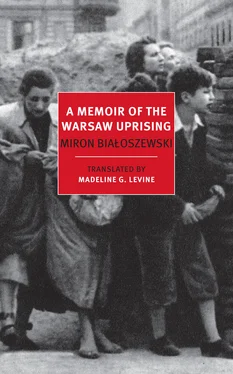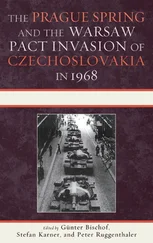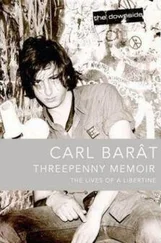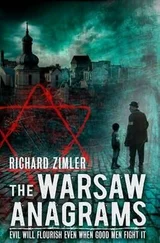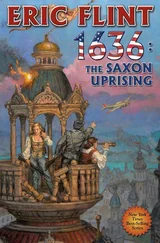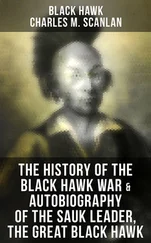Miron Bialoszewski - A Memoir of the Warsaw Uprising
Здесь есть возможность читать онлайн «Miron Bialoszewski - A Memoir of the Warsaw Uprising» весь текст электронной книги совершенно бесплатно (целиком полную версию без сокращений). В некоторых случаях можно слушать аудио, скачать через торрент в формате fb2 и присутствует краткое содержание. Год выпуска: 2015, Издательство: NYRB Classics, Жанр: Биографии и Мемуары, на английском языке. Описание произведения, (предисловие) а так же отзывы посетителей доступны на портале библиотеки ЛибКат.
- Название:A Memoir of the Warsaw Uprising
- Автор:
- Издательство:NYRB Classics
- Жанр:
- Год:2015
- ISBN:нет данных
- Рейтинг книги:4 / 5. Голосов: 1
-
Избранное:Добавить в избранное
- Отзывы:
-
Ваша оценка:
- 80
- 1
- 2
- 3
- 4
- 5
A Memoir of the Warsaw Uprising: краткое содержание, описание и аннотация
Предлагаем к чтению аннотацию, описание, краткое содержание или предисловие (зависит от того, что написал сам автор книги «A Memoir of the Warsaw Uprising»). Если вы не нашли необходимую информацию о книге — напишите в комментариях, мы постараемся отыскать её.
A Memoir of the Warsaw Uprising — читать онлайн бесплатно полную книгу (весь текст) целиком
Ниже представлен текст книги, разбитый по страницам. Система сохранения места последней прочитанной страницы, позволяет с удобством читать онлайн бесплатно книгу «A Memoir of the Warsaw Uprising», без необходимости каждый раз заново искать на чём Вы остановились. Поставьте закладку, и сможете в любой момент перейти на страницу, на которой закончили чтение.
Интервал:
Закладка:
There were also flamethrowers. We didn’t know what they looked like. Either of them. At first you could only hear three to six creaking screeches and right afterwards just as many explosions and wind blasts. People used to say when they heard those screeches, “They’re cranking up the wardrobe again…”
And right away a humorous verse about the cranking up of the wardrobe appeared, and we even read it in the newspaper.
Throwers — that was a proper name. Because those wind blasts threw us and the walls about.
But let us return to the tram driver’s girlfriend. She waited for him till evening. He didn’t return. She didn’t sleep that night. She cried. He didn’t return in the morning. We consoled her. I think we stopped consoling her several hours later. Because there was no longer any reason to. At this moment I’m no longer so certain that that was on the twelfth. But maybe it was. There’s only one thing that makes me uncertain. The next day was the thirteenth. The famous day of the explosion of the Goliath on Długa Street.[11] So perhaps I’m right after all. Even before the Goliath, on the morning or the afternoon of the thirteenth, the tram driver’s girlfriend asked us, “Could you help me search for him in the hospitals?”
“Of course!”
And the three of us — she, Swen, and I — raced to the city.
Or perhaps it was the fourteenth after all? Because the thirteenth was a Sunday. But no. Only two Sundays and one holiday, definitely August 15, a Sunday and a holiday. Sundays didn’t differ from each other in any way. How could they? After all, which of the eyewitnesses has ever associated the explosion of the Goliath with a Sunday? That’s probably proof.
That a short period of time appeared long is not surprising. Every day people would say, “It’s already the twelfth day of the uprising.” “It’s already the thirteenth day of the uprising.”
It seemed as if we already had entire years of this behind us, and what was there ahead of us? There never had been, nor would there ever be, anything else, only the uprising. Which it was impossible to endure much longer. Each day it was impossible to endure it much longer. Then each night. Then every two hours. Then every fifteen minutes. Yes. People kept track of time incessantly. They listened to the air or felt the ground to see if it was trembling or not. Where are they? The eastern front? Somewhere beyond the Vistula, or where? In Wiśniewa? In Piekiełko? People listened to the radio or to those who listened to the radio, which is to say, to what was happening in the west. There too (since June) a front was on the move. French cities were being liberated. Belgian cities. And us? There were parachute drops. Arms. They flew over more than once. First those from the west. The Allies. Mostly they were Poles in those planes. Mostly or exclusively. Someone told a story about how once a whole fleet of those airplanes flying from somewhere in England or Africa with supplies for us struck a cold air front over the Alps (I think). All the engines froze. And all of them crashed on the spot. Once at night an airplane from the Union of South Africa crashed right in front of our eyes. Into Praga. Another crashed on Miodowa Street. Where it joins Krasiński Square. Right onto the barricade that already had a tram car on top of it. The fliers were pulled out. I happened to meet them — that August 13—by accident. They were Poles. Too.
Where Długa Street intersects Kiliński near the Garrison Church on the side facing the Vistula, of course, new hospitals had been set up in various cellars. Organized right at that time. Mainly because of the Goliath. According to a version I heard recently from an acquaintance of mine, a teacher who was there, on August 13, on that incomprehensible Sunday, late in the day, probably after sundown, a Goliath released by the Germans turned into Freta Street from Świętojerska. Just a little tank. Rather, a robot tank. At first no one knew that it had been set loose. Rather, it appeared to have been abandoned. Or allowed to come close. And it was captured by the Poles. At once crowds of people rushed up to cheer. They followed the trophy, walking alongside of it. They turned from Freta into Długa. And somewhere near the exit onto Kiliński Street, when the euphoria had reached its peak and the balconies were jammed with people, a catastrophe occurred. The timing mechanism went off. The balconies were left with lots of figures draped over the iron railings. The majority of the corpses, pieces of legs, hands, guts, clothing were found in the garden plots at the center. Those new hospitals came into being that night. My teacher friend had two brothers who were taking part in the action. One — the elder — perished in a skirmish. The other, just a boy, was helping with something over there. He was always rushing about. That’s what he was doing then, too. They, my friend and her mother, that is (they had escaped from Wola), were sitting in the cellar when the younger brother was on Długa. His sister (my friend) rushed outside. She searched for him. After the explosion. Because someone told her that the kid had been there. And in the garden, grassless at that time, on the bare earth, she found a piece of his leg with his shoe still on it. Someone said, however, that her kid brother was alive and no doubt was in the new hospital. She wanted to go inside. But they wouldn’t let her in. Because they were just setting it up. By the next day the hospital had already been bombed. Irena P., when I saw her again during the uprising in Starówka, I think, said (she too had been there then) that they’d had to collect the guts with shovels.
When we rushed out with the tram driver’s girlfriend onto Rybaki Street, we first checked the hospital on the corner of Rybaki and Boleść. In the Gunpowder Depot. There was a hospital there on the ground floor. The tram driver wasn’t there. They told us that if the wounded man wasn’t from the military it was more likely that he was somewhere on Długa.
Rybaki Street already looked different from what it had been like at the beginning. Every few steps there were barricades of earth, steel rails, paving stones, and concrete with narrow little crannies near the wall. The walls of the old driveway and the two shell-like gates of chipped plaster were pockmarked. The houses were already losing their normal contours. Their height. The lines of their façades.
From the corner of Boleść we turned back a short way in the direction from which we had come (Kościelna). Right at the bend, as has already been described, was the wall at which the gardens of the Dominicans, dropping down from the hill and intersected by Stara Street, came to an end. In this wall, described several pages back, was the gate that has also been described already, the same gate with the monstrance that marked the beginning of the Staromiejski route from lower to upper Stare Miasto. After dashing through the gate you immediately made a sharp left turn. Then you raced toward the garbage bin near the opposite wall. You jumped onto the table placed beside it. From the table onto the garbage bin. From the garbage bin (a bin of the old kind with a lid) through a hole in the wall. And you were on a slightly higher level, or, rather, at the bottom of the courtyard from which you could scurry along a board through a window, from the window into someone’s apartment, from that apartment through a hole in the wall into some other dark place that was at ground-floor level at one end but was a cellar in the middle of the building. There you landed blindly amid a crowd of people who were sitting or lying down, some of whom were even wounded. Some of them cried out, “Jesus!… don’t trample us… Jesus!”
From there, you raced along various turnings in the dark up to some higher place, out into the courtyard. From that yard through a gate. Out to Mostowa Street. Here you ran across the street at an angle, stealthily, behind the barricade. Across cobblestones. From there you could always see a bit of blue sky and the Vistula through a chink in the wall. The street runs downhill. And that barricade was considered both a lookout and a front. Often, partisans were lying on it and firing at Wybrzeże and Praga. Perhaps even at those legendary trees with the Germans and their binoculars. On the other side of Mostowa (there were buildings there then) you hurried through the gate of the lower courtyard of the Gdańsk Cellar. Or perhaps that wasn’t the Gdańsk Cellar but only its vicinity. Somewhat lower down. It seems to me that the oldest hospital in Warsaw, St. Lazarus (I remember its burnt-out walls were still standing, adhering to the ancient ramparts, when it was uncovered after the war; they dismantled the monument), stood, I think, directly opposite the entrance from Mostowa near that first lower courtyard. If there really were two courtyards there. And behind the hoardings, or the wall, at least behind the wide-open wooden gate, it seems there was a second courtyard. Also with cobblestones. And that was the one that housed the Gdańsk Cellar. The Gdańsk Cellar has always been a famous building. My grandmother lived in it. My father spent entire months there as a child around 1905. The Gdańsk Cellar stood four stories above that courtyard with its cobblestones and gray cats always sitting on them, or, rather, it was four stories counting from below or two above the upper level, which faced Freta Street, or the front. The stairs were wooden. Also with cats on them. I remember that from before the war. Only at that time no one knew either about the landmark value of St. Lazarus (which had been reconstructed, after all, built onto, renovated, like the majority of such buildings in Warsaw, so that it was difficult to see it as a monument), nor did anyone know that the Gdańsk Cellar, in addition to its elaborate construction, was a parasite on the remains of the barbican. So you rushed into a stairwell. Up to the third floor. And after racing through the passageway you realized that it was the ground floor on Freta Street. Then came the gate and then, right away, the street. The hill of Stare Miasto. On this route, in the Gdańsk Cellar and its exit onto Freta, at the intersection of Długa, Nowomiejska, and Mostowa Streets, people were always passing by quickly, in crowds. They would walk past once or twice. Searching. Taking care of things. And they would rush on. Długa was always the most central and important street.
Читать дальшеИнтервал:
Закладка:
Похожие книги на «A Memoir of the Warsaw Uprising»
Представляем Вашему вниманию похожие книги на «A Memoir of the Warsaw Uprising» списком для выбора. Мы отобрали схожую по названию и смыслу литературу в надежде предоставить читателям больше вариантов отыскать новые, интересные, ещё непрочитанные произведения.
Обсуждение, отзывы о книге «A Memoir of the Warsaw Uprising» и просто собственные мнения читателей. Оставьте ваши комментарии, напишите, что Вы думаете о произведении, его смысле или главных героях. Укажите что конкретно понравилось, а что нет, и почему Вы так считаете.
